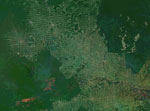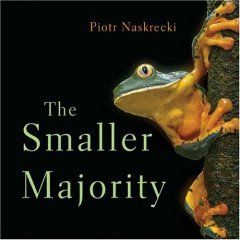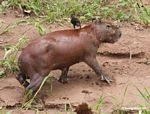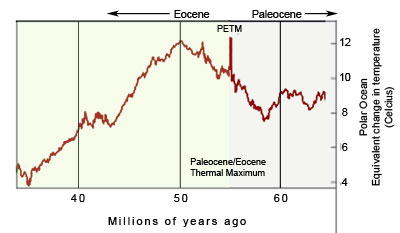January 28, 2006
The collapse of orangutan populations coincided with the arrival of colonial powers on the island of Borneo and accelerated timber extraction according to a new model developed by wildlife geneticists from Cardiff School of Biosciences. The study is among the first to link species decline with colonial deforestation, as opposed to when humans first appeared in the region.
The top climate scientist at NASA says the current administration has tried to censor his work on climate change according to an article in The New York Times. James E. Hansen, director of the agency's Goddard Institute for Space Studies, claims that officials at NASA headquarters have ordered the public affairs staff to review his coming lectures, papers, and web site postings. Dr. Hansen said he would ignore the restrictions.
I will be out of contact for a few days and will not be updating the site. There will be some new material later next week.
January 27, 2006
Using ethanol -- alcohol produced from corn or other plants -- instead of gasoline is more energy-efficient than oil say researchers at the University of California, Berkeley. In a study published in today's issue of the journal Science, Berkeley scientists show that producing ethanol from corn uses much less petroleum than producing gasoline, suggesting that ethanol can help lessen the country's reliance on imported oil.
Global warming will cause sea levels to rise up to 34 centimeters (11 inches) by the end of the century, causing increased flooding, worsening the impact of storms, damaging low-lying ecosystems, and accelerating coastal erosion, according to a new study by Australian researchers.
Older forests have a greater diversity of trees than younger forests according to research published in Friday's issue of the journal Science. The study -- conducted by 33 ecologists from 12 countries -- found that nature encourages diversity by selecting for less common trees as the trees mature, indicating that diversity has ecological importance to tropical forests.
January 26, 2006
Tropical deforestation rates have skyrocketed in Uganda and Burundi, while declining significantly in Rwanda according to new analysis of data from the Food and Agriculture Organization (FAO) of the United Nations.
Hugo Chavez, Venezuela's president, announced a plan to build a massive gas pipeline that would carry natural gas from the oil rich state 5,000 miles south. Environmentalists fear that the project could damage the Amazon rain forest by polluting waterways and creating roads that would attract developers and poor farmers, while analysts question the wisdom and viability of the plan which may cost $20-50 billion depending on who makes the estimate.
Researchers studying supplies of copper, zinc and other metals have determined that these finite resources, even if recycled, may not meet the needs of the global population forever.
Scientists have found the smallest known fish in the peat swamps of Sumatra, an island in Indonesia.
January 25, 2006
A new study shows that parks and indigenous reserves in the Amazon help slow deforestation. The study, conducted by researchers at the Woods Hole Research Center and the Instituto de Pesquisa Ambiental da Amazonia, analyzed the effectiveness of protected areas against forest clearing using quantitative analysis of satellite data. The study found that deforestation was 1.7 to 20 times higher along the outside versus the inside perimeter of reserves, while fires were 4 to 9 times higher. Indigenous lands also slowed forest clearing in high-deforestation frontier regions.
A new study by NASA indicates that 2005 was the warmest year in at least a century, surpassing 1998. According to their data, the five warmest years over the last century have occurred since 1997: 2005, then 1998, 2002, 2003 and 2004.
The number of Africans requiring food assistance has doubled in the past decade due to crop failures, drought, failing governments, civil strife, and the impact of AIDS, said the United Nations World Food Programme. The World Food Programme says it will to provide food assistance this year to some 43 million people across Africa, including some 35 million in need of emergency food aid, for a total of over $1.8 billion.
January 24, 2006
Protecting coral reefs and mangrove forests makes economic sense according to a new report by the United Nations Environment Programme (UNEP). The report argues that conserving these ecosystems for the services they provide--from fisheries protection to erosion control to a source for medical compounds--is cost-effective relative to destroying them and substituting their role with man-made structures. UNEP estimates the value of coral reefs is between US$100,000 to US$600,000 per square kilometer a year while the cost of protecting them, through the management costs of a marine protected area, is just US$775 per square kilometer annually.
Researchers in France and at Harvard University have found that isolated indigenous peoples deep in the Amazon readily grasp basic concepts of geometry such as points, lines, parallelism and right angles, and can use distance, angle and other relationships in maps to locate hidden objects. The results suggest that geometry is a core set of intuitions present in all humans, regardless of their language or schooling.
January 23, 2006
West Africa's once verdant and extensive rainforests are now a historical footnote. Gone to build ships and furniture, feed hungry mouths, and supply minerals and gems to the West, the band of tropical forests that once extended from Guinea to Cameroon are virtually a memory. The loss of West Africa's rainforests have triggered a number of environmental problems that have contributed to social unrest and exacerbated poverty across the region. According to data provided by the United Nations, today about 1.5% of West Africa has primary forest cover.
January 22, 2006
What should be done to save rainforests? Here are five basic steps: 1) Teach others about the importance of the environment and how they can help save rainforests. 2) Restore damaged ecosystems by planting trees on land where forests have been cut down. 3) Encourage people to live in a way that doesn't hurt the environment. 4) Establish parks to protect rainforests and wildlife.
5) Support companies that operate in ways that minimize damage to the environment. Note that the first letter of each point spells the acronym "TREES."
January 21, 2006
Rainforests around the world still continue to fall. Does it really make a difference? Why should anyone care if some plants, animals, mushrooms, and microorganisms perish? Rainforests are often hot and humid, difficult to reach, insect-ridden, and have elusive wildlife. Actually the concern should not be about losing a few plants and animals; mankind stands to lose much more. By destroying the tropical forests, we risk our own quality of life, gamble with the stability of climate and local weather, threaten the existence of other species, and undermine the valuable services provided by biological diversity.
January 20, 2006
Despite increased awareness of the importance of tropical rainforests, deforestation rates have not slowed. Analysis of figures from the Food and Agriculture Organization of the United Nations (FAO) shows that tropical deforestation rates increased 8.5 percent from 2000-2005 when compared with the 1990s, while loss of primary forests may have expanded by 25 percent over the same period. Nigeria and Vietnam's rate of primary forest loss has doubled since the 1990s, while Peru's rate has tripled. Industrial logging, conversion for agriculture (commercial and subsistence), and forest fires--often purposely set by people--are responsible for the bulk of global deforestation today.
January 19, 2006
Madagascar introduced a new park management system, the System of Protected Areas of Madagascar (SAPM). SAPM simplifies the legal process used to create a protected area and permits varying degrees of sustainable resource use to contribute to poverty reduction and sustainable development.
January 18, 2006
A week after announcing their surprising discovery that plants release 10 to 30 percent of the world's methane--a potent greenhouse gas--researchers from the Max Planck Institute for Nuclear Physics warn that plants should not be blamed for recent global warming. The scientists say that because emissions from plants are a natural source, they have existed long before man's influence started to impact atmospheric concentrations of greenhouse gases. Anthropogenic emissions--especially agricultural cultivation--are responsible for the well-documented increase in atmospheric methane since pre-industrial times. Emissions from plants contribute to the natural greenhouse effect and not to the recent temperature increase usually referred to as "global warming".
Public support for environmental protection in the United States as a federal government priority has dropped substantially since 2001 according to new analysis. After analyzing national polls by the Pew Research Center for the People and the Press, Michael Greenberg, a professor and associate dean at the Edward J. Bloustein School of Planning and Public Policy at Rutgers, found that the public cares less about a cleaner environment than it did before the September 11, 2001 attacks. Further, with the exception jobs and the economy, Americans are less interested in a range of domestic priorities including crime prevention and health care management. Greenberg says the data shows that the former champions of environmental policy ñ non-Hispanic white, middle-class, college-educated and suburban residents ñ are now the least supportive of such efforts.
January 17, 2006
The forest floor of primary tropical rainforest is rarely the thick, tangled jungle of movies and adventure stories. It is actually quite the opposite: the floor is relatively clear of vegetation due to the deep darkness created by perhaps 100 feet (30 m) of canopy vegetation above. The canopy not only blocks out sunlight, but damps wind and rain. Despite its constant shade, the ground floor of the rainforest is the site for important interactions and complex relationships. The forest floor is one of the principal sites of decomposition, a process paramount for the continuance of the forest as a whole. It is also home to thousands of plants and animals, and provides support for trees responsible for the formation of the canopy.
A new study warns that declining populations of key pollinators may be putting plants at risk of extinction in some of the world's most biodiverse places. The National Science Foundation-sponsored research found that ecosystems with the greatest number of species, including the tropical rainforests of South America and southeast Asia, have larger deficits in pollination compared to the less-diverse ecosystems.
January 16, 2006
Fed by tremendous amounts of rainfall, tropical rainforests have some of the largest rivers in the world including the Amazon, Mekong, Negro, Orinoco, and Congo. These rivers are home to a majority of the world's freshwater tropical fish species and serve as an important source of food for millions of people.
Piotr Naskrecki of Conservation International just published a beautiful book on some of the world's little creatures. Titled The Smaller Majority, the work features hundreds of gorgeous photographs of insects, frogs, lizards, and other small wildlife from around the world. Accompanying the photos is a well written narrative that explains complex biological processes in a clear and engaging manner while discussing important conservation issues. Check it out.
January 15, 2006
Tropical rainforests have long been home to indigenous peoples who have shaped civilizations and cultures based on the environment in which they live. Great civilizations like the Mayas, Incas, and Aztecs developed complex societies and made great contributions to science. Living from nature and lacking the technology to dominate their environment, native peoples have learned to watch their surroundings and understand the intricacies of the rainforest. Over generations these people have learned the importance of living within their environment and have come to rely on the countless renewable benefits that forests can provide.
January 14, 2006
Researchers from the Max Planck Institute for Nuclear Physics made the surprising discovery that plants release 10 to 30 percent of the world's methane—a potent greenhouse gas. The scientists say that most of the recent increase in methane concentrations in the atmosphere results from human activities, especially agricultural cultivation. The finding has important implications for how policymakers address climate change.
A new report released by the Worldwatch Institute says that Earth lacks the energy, arable land and water to enable the fast-growing economies of China and India to attain Western levels of resource consumption. The environmental think tank observes that China and India, are becoming not only economic powers, but "planetary powers that are shaping the global biosphere" and affecting world economic policies.
January 13, 2006
An estimated 70-90 percent of life in the rainforest exists in the canopy -- the layer of overlapping tree branches and foliage formed by the crowns of adjacent trees. The newly revised canopy section of the rainforest site looks at this fundamental part of the rainforest ecosystem.
California approved a $2.9 billion solar energy program to make California one of the world's largest producers of solar power. The plan would add 3,000 megawatts of solar energy over 11 years through the installation of 1 million rooftop solar energy systems on homes, businesses, farms, schools and public buildings. The amount of electricity generated would be equivalent to about six new power stations. Solar power could save California utility customers an estimated $9 billion from a reduced need to build new power plants and purchase electricity supplies at peak demand.
January 12, 2006
A revised look at rainforest biodiversity: Tropical rainforests support the greatest diversity of living organisms on Earth. Although they cover less than 2 percent of Earth's surface, they house an estimated 50 percent of all life on the planet. A tropical rainforest may have more than 480 tree species in a single hectare and over a thousand species of butterflies. This diversity is not a haphazard event, but is the result of a series of unique circumstances.
US Energy Secretary, Samuel Bodman, told the Asia-Pacific Partnership on Clean Development and Climate--a rival to the Kyoto Protocol on limiting greenhouse gas emissions--that the private sector will solve the problem of climate change. Bodman said the government's role in fighting climate change is to help businesses adopt up clean technologies. His stance was backed by his equivalent in the Australian government, Ian Macfarlane, who said "the real emissions are coming from industry. And it's industry which needs to embrace the technology, it's industry which needs to be in a partnership with government to involve this new technology, to take up its corporate environmental community responsibility, to set about ensuring that in 50 years' time our emissions aren't 50% higher than now."
Scientists from Bristol University said on Wednesday they had uncovered the first proof of teaching in non-human animals -- ants showing each other the way to food.
January 11, 2006
The dramatic global decline of amphibians may be directly connected to global warming warns a new study published in the journal Nature. Looking at a group of frogs found in biodiversity hotspots in Central and South America, scientists linked higher temperatures to frog extinctions caused by a skin fungus. The infectious skin disease--a type of chytrid fungus (Batrachochytrium dendrobatidis)--is now found in frog populations around the world and is the main suspect in the rapid disappearance of amphibians.
In commentary published with the frog article in Nature, a leading extinction expert said that the decline in frogs is another key example of unanticipated and complex impacts from climate change. He said the amphibian crisis is a harbinger of much greater biological disruption. What had been seen as an enigma is now understood as a complex relationship between global warming and major extinction of species.
Deforestation has destroyed 17 percent of the Pantanal, the world's largest wetland, according to a new report from Conservation International. The Pantanal, an area of flooded grassland and savanna covering 200,000 square kilometers during the rainy season, includes parts of Brazil, Paraguay, and Bolivia and is fed by the Rio Paraguay. The wetland is home to some 3500 species of plant and 650 species of birds. About 125 types of mammals, 180 kinds of reptiles, 41 types of amphibians, and 325 species of fish have been found in the region. The Pantanal in an important source of freshwater to neighboring farming areas and downstream urban areas.
January 10, 2006
NASA climate modelers have simulated the climate changes caused by a massive deluge of freshwater into the North Atlantic that occurred near the end of the last Ice Age 8,000 years ago. At the time, retreating glaciers opened a route for two giant lakes known as Agassiz and Ojibway to rapidly and prodigiously drain into the North Atlantic ocean. Scientists believe that the tremendous influx of freshwater in the North Atlantic interfered with the ocean's thermohaline circulation, which distributes heat around the globe, and may have caused average air temperatures to drop several degrees in some areas of the Northern Hemisphere. While the flood was catastrophic, the researchers found it had much milder effects around the globe than many people feared.
January 9, 2006
With the official establishment of the Makira Protected Area last week, Madagascar reached a conservation milestone -- one million hectares (3,800 square miles) of area under protection. Makira and neighboring Masoala National Park form the largest contiguous tract of rainforest under protection on the island and biologists say that one percent of the planet's biodiversity is found in the forests of the combined parks, including more than a dozen species of lemurs.
January 7, 2006
Logging increases the risk of fire according to a new assessment in the aftermath of a large fire in Oregon. The study also found that undisturbed areas may be at lower fire risk. The research comes at a time when primary forest is declining worldwide. The Food and Agriculture Organization of the United Nations (FAO) says that 6 million hectares of primary forests is lost each year. Primary forests -- forests with no visible signs of past or present human activities -- are considered the most biologically diverse ecosystems on the planet. Research in other parts of the world suggests that primary forest has lower fire risk than secondary and degraded forest.
January 6, 2006
In the future, illegally harvested timber could be tracked by scent according to researchers at Oregon State University. The wood-sniffing device would allow the timber industry to certify that individual products come from sustainably harvested operations and cut down on illegal logging. Such a device could prove cost-effective for the timber industry and governments of timber-exporting countries. According to World Bank estimates, governments lose about US$5 billion in revenues annually as a result of illegal logging while overall losses to the national economies of timber producing countries add up to an additional US$10 billion per year.
January 5, 2006
Massive climate change 55 million years ago caused major disruption to ocean currents according to new research by scientists at Scripps Institution of Oceanography. A rapid rise in global temperatures during the Palaeocene-Eocene Thermal Maximum triggered many global shifts, including a reversal of ocean currents and large-scale changes in global biodiversity. Scientists are concerned that similar changes could result from modern-day global warming. Already, there is growing evidence to suggest a slow-down in North Atlantic currents that help keep Europe relatively warm.
January 4, 2006
Tropical deforestation rates continue to climb according to figures released by the Food and Agriculture Organization of the United Nations (FAO). Analysis of FAO data shows that tropical deforestation rates increased 8.5 percent from 2000-2005 when compared with the 1990s, while loss of primary forests expanded by almost 24 percent over the same period. Nigeria and Vietnam's rate of primary forest loss doubled since the 1990s, while Peru's rate more than tripled.
January 3, 2006
Russia's folly, an opportunity for renewable energy? With its willingness to use energy as a political instrument, Russia has provided the world with further incentive to pursue renewable energy. The Kremlin has shown it cannot be counted upon as a reliable source of energy and western markets should see this as an opportunity to take a long, thoughtful look at energy security and re-evaluate the benefits of developing renewable energy technologies.
January 2, 2006
The first three sections of the rainforest site -- World Rainforests, Rainforest structure, and Biodiversity -- have been revised. Other sections will be revised and changed over to the new format in the near future.
















